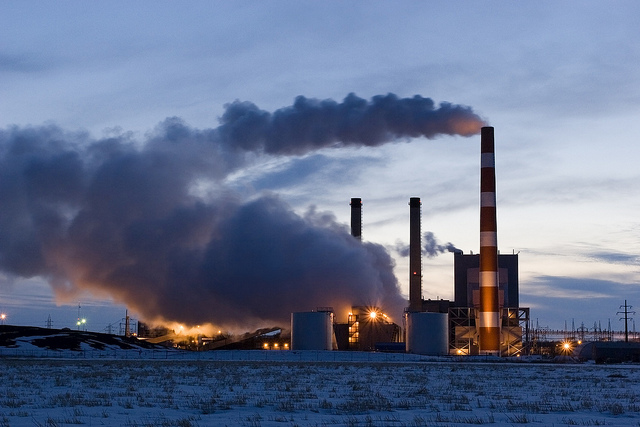Carbon Emissions on Tragic Trajectory

Global CO2 emissions are projected to rise 2.1 percent higher than 2012, the previous record high, according to a new report released Tuesday by the Global Carbon Project.3
This increase is slightly less than the 2000-2013 average of 3.1 percent, said lead author Corinne Le Que?re? of the Tyndall Centre for Climate Change Research in the UK.
"This is the second year in a row of below average emissions. Perhaps this represents cautious progress," Le Que?re? told IPS.
Still, these hard numbers demonstrate that the U.N. climate talks have failed to curb the growth in emissions. And there is little optimism that the latest talks known as COP19 here in Warsaw will change the situation even with the arrival of high-level ministers Wednesday.
Global emissions continue to be within the highest scenario of the Intergovernmental Panel on Climate Change (IPCC), she said.
"This is a five-degree C trajectory. It's absolutely tragic for humanity to be on this pathway," Le Que?re? said.
This year's 36 billion tonnes of CO2 will raise the planet's temperature about 0.04 degrees C for thousands of years. Every tonne emitted adds more warming, she said. (If one tonne of CO2 was a second, 36 billion seconds equals about 1,200 years.)
CO2 levels in the atmosphere have risen about 40 percent in the last century. The oceans have absorbed 97 percent of the additional heat from those emissions, which is the only reason global temperatures have not risen much faster. However, the oceans will not continue to soak up all the extra heat forever.
Who is most responsible for the 2013 emissions?
In total volume it's China, with 27 percent of the total. But Australia's emissions per person are nearly three times higher than China's. The other big emitters are the United States at 14 percent, the European Union at 10 percent, and India at six percent, the Global Carbon Project report says. The Project is co-led by researchers from the Tyndall Centre for Climate Change Research at the University of East Anglia.
While emissions grew year on year in China and India, U.S. emissions declined 3.7 percent. This reflects the switch from coal to gas as a result of the boom in natural gas production. Gas contains less CO2 than coal. However, U.S. coal exports soared.
"The shale gas boom in the U.S. is making more fossil fuels available, resulting in greater overall emissions," said Le Que?re?.
A new tool anyone can use to explore where emissions are coming is also being released Tuesday. The Global Carbon Atlas is an online platform that allows anyone to see what their country's emissions are and compare them with neighbouring countries - past, present, and future. It shows the biggest carbon emitters of 2012, what is driving the growth in China's emissions, and where the UK is outsourcing its emissions.
The Atlas clearly shows that coal is the biggest source of emissions in 2013. It is the "dirtiest" fossil fuel by far for the climate. This is true even with the most modern, efficient coal power plant.
Poland generates 86 percent of its energy from coal and hopes to grow this industry even though it is hosting the U.N. climate talks. In a shock to many, it is also hosting the World Coal Summit this week.
"Our people are suffering because of climate change. I can't believe the Polish government is ignoring this by hosting that summit," said Robert Chimambo of the Zambia chapter of the Pan African Climate Justice Alliance (PACJA).
"Millions and millions of people are going to die in future just so coal companies can gain profits," Chimambo told IPS.
"There is no such thing as clean coal. Energy companies should never get a social license to build another coal plant," said Samantha Smith, head of the global climate and energy initiative at the World Wildlife Fund (WWF).
Although the coal industry talks about carbon capture and storage (CCS), it is too expensive and there are not enough places to store the captured CO2, Smith told IPS.
For developing countries, renewable energy is faster, cheaper, more decentralised and has the benefit of not polluting the air, water or land, she said.
The narrowing carbon budget is another reason to pursue green energy. To have a reasonable chance of staying below two degrees C in coming decades, cumulative emissions must not exceed 2,900 billion tonnes of CO2, the IPCC says, and 69 percent of that is already in the atmosphere. It bears repeating that even two degrees C is not safe given the increases in extreme weather, ocean acidification, melting of Arctic sea ice and other impacts already seen with the 0.8C of current heating.
"We have exhausted about 70 percent of the cumulative emissions that keep global climate change likely below two degrees," said Pierre Friedlingstein at the University of Exeter in UK.
This knowledge doesn't seem to make a difference to most political leaders or delegates at the U.N. climate talks. Some like Canada and Japan either don't care or fail to realise their responsibility, said Le Que?re?.
"My message to delegates in Warsaw is for every country to make the most stringent cuts they can now. If we wait till after 2020 it will far more difficult and expensive," she said. "We have the solutions. Going beyond two degrees C is very risky, it's completely unknown territory."
© Inter Press Service (2013) — All Rights ReservedOriginal source: Inter Press Service
 Global Issues
Global Issues